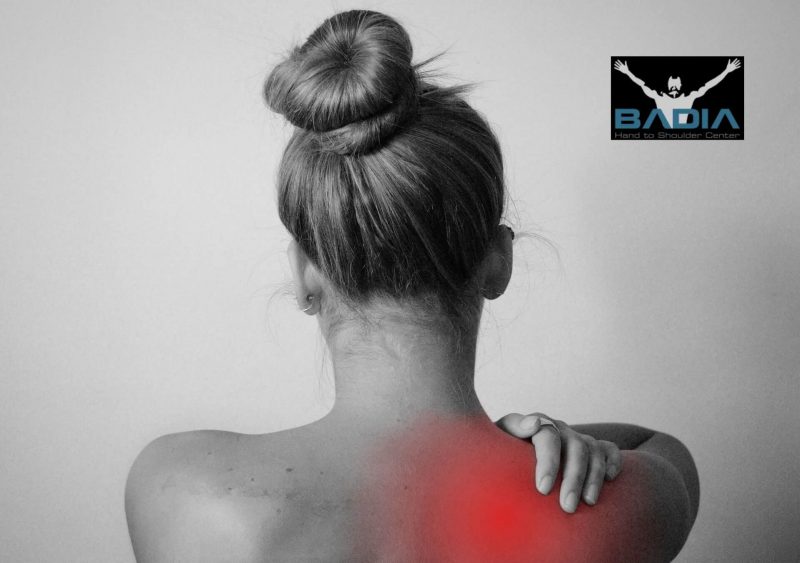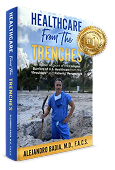PREVENCIÓN & TERAPIA
Más allá de la cirugía: Explorando tratamientos no quirúrgicos efectivos para el dolor crónico de hombro

Si usted vive con dolor crónico de hombro, sabe cuánto puede interferir con la vida diaria, desde vestirse por la mañana hasta alcanzar objetos por encima de la cabeza, o simplemente lograr dormir bien por la noche.
Afortunadamente, la cirugía no es su única opción. Una amplia gama de tratamientos no quirúrgicos para el alivio del dolor de hombro puede ayudar a reducir el malestar, restaurar el movimiento y mejorar su calidad de vida.
Para ayudarle a tomar decisiones bien informadas con respecto a su atención, hemos examinado a continuación algunas alternativas realistas y científicamente respaldadas a la cirugía de hombro.
¡ATENCIÓN! Si sufre de dolor de hombro, el Dr. Badia y su equipo están aquí para brindar una perspectiva experta. Programe una consulta en el Badia Hand to Shoulder Center para ganar claridad y confianza en su camino de tratamiento.
Causas comunes del dolor crónico de hombro
Según la Asociación Internacional para el Estudio del Dolor (IASP), el dolor se considera crónico cuando persiste más allá del tiempo normal de curación, típicamente definido como más de 3 meses. Por lo tanto, el dolor de hombro que dura más de 3 meses puede clasificarse como crónico.
Algunas de las causas más frecuentes incluyen:
- Problemas del manguito rotador: inflamación, degeneración o desgarros que causan debilidad y dolor con el uso por encima de la cabeza.
- Hombro congelado: rigidez y movimiento restringido, a menudo relacionado con diabetes o afecciones de la tiroides.
- Inestabilidad del hombro: holgura o deslizamiento debido a dislocaciones previas.
- Artritis de la articulación acromioclavicular (AC): dolor en la parte superior del hombro, especialmente con el movimiento cruzado del cuerpo.
Según la Academia Estadounidense de Cirujanos Ortopédicos (AAOS), pueden recomendarse pruebas de imagen como resonancia magnética o ultrasonido para determinar la causa exacta antes de comenzar el tratamiento.
Fisioterapia: Una piedra angular de la recuperación no quirúrgica
La fisioterapia suele ser el primer y más eficaz paso en el tratamiento del dolor crónico de hombro sin cirugía. Un programa personalizado guiado por un terapeuta licenciado puede:
- Fortalecer los músculos de soporte
- Mejorar la movilidad del hombro y el rango de movimiento
- Reducir la inflamación y el malestar
- Enseñar la mecánica corporal adecuada para prevenir futuras lesiones
Los siguientes ejercicios se recomiendan comúnmente como parte del manejo conservador para el dolor crónico de hombro.
Siempre consulte a su médico o fisioterapeuta antes de comenzar cualquier programa de ejercicios, especialmente si su dolor es severo o aún no ha sido diagnosticado.
- Ejercicio de péndulo: Inclínese hacia adelante con su brazo sano apoyado. Deje colgar el brazo dolorido y balancéelo suavemente en pequeños círculos. Repita durante 30 segundos en cada dirección.
- Estiramiento del durmiente (Sleeper stretch): Acuéstese de lado sobre el brazo dolorido doblado. Use su otra mano para presionar suavemente el antebrazo hacia abajo hasta sentir un ligero estiramiento. Mantenga durante 20-30 segundos.
- Compresión de omóplatos: Siéntese o párese derecho. Junte suavemente los omóplatos (sin encoger los hombros). Mantenga durante 5 segundos. Repita 10-15 veces.
- Caminata por la pared: Frente a una pared, suba los dedos caminando hacia arriba tanto como pueda. Haga una breve pausa y luego regrese al inicio. Repita 10 veces.
- Rotación externa con banda de resistencia (si se prescribe): Con el codo doblado a 90 grados y una banda anclada a la altura de la cintura, rote el antebrazo hacia afuera. Realice 10-15 repeticiones si se prescribe.
Medicamentos e inyecciones para el manejo del dolor
Cuando se maneja adecuadamente, muchos casos de dolor de hombro crónico pueden mejorar con fisioterapia y ejercicio dirigido. Sin embargo, en algunos casos, se puede utilizar apoyo adicional a través de medicamentos o inyecciones para ayudar a controlar el dolor y la inflamación, especialmente durante los brotes o cuando los síntomas limitan el progreso con la terapia basada en el movimiento.
Según el artículo de revisión Diagnosis and Treatment of Chronic Painful Shoulder: Review of Nonsurgical Interventions (Diagnóstico y tratamiento del hombro doloroso crónico: revisión de intervenciones no quirúrgicas) del Dr. James R. Andrews y sus colegas, el uso estratégico de intervenciones no quirúrgicas puede reducir significativamente el dolor y mejorar la función en muchas afecciones crónicas del hombro.
Medicamentos orales
Los AINE de venta libre como el ibuprofeno o el naproxeno pueden ayudar a aliviar el dolor a corto plazo. Funcionan reduciendo la inflamación, pero su uso debe ser limitado, ya que el uso a largo plazo puede provocar efectos secundarios como irritación estomacal, sangrado gastrointestinal, tensión renal y presión arterial elevada.
Opciones tópicas e intramusculares
Los geles o cremas de AINE tópicos pueden dirigirse al dolor localizado con menos efectos secundarios sistémicos. Las inyecciones intramusculares de AINE también pueden usarse para alivio a corto plazo.
Inyecciones de corticosteroides
Las inyecciones de esteroides en la articulación del hombro pueden ayudar a reducir la inflamación y mejorar el movimiento, especialmente en condiciones como el hombro congelado o la bursitis. El alivio suele ser temporal, durando de unas pocas semanas a unos pocos meses. Estas inyecciones son más efectivas cuando se combinan con fisioterapia. Debe evitarse el uso repetido, ya que puede debilitar los tendones o dañar el tejido articular. Los riesgos incluyen infección, adelgazamiento de la piel e inestabilidad articular.
Modificación de la actividad y dispositivos de apoyo
Pequeños cambios en cómo mueve o apoya su hombro pueden marcar una gran diferencia. Estos ajustes cotidianos pueden incluir:
- Evitar movimientos por encima de la cabeza o tareas repetitivas que aumenten el malestar
- Usar un aparato ortopédico, cabestrillo o cinta de kinesiología para dar soporte adicional a la articulación durante la actividad
- Cambiar su posición al dormir para quitar presión del hombro
Estos pasos simples ayudan a reducir la tensión mientras le permiten mantenerse activo y cómodo durante la recuperación.
Explorando terapias complementarias para la salud del hombro
Las terapias complementarias pueden ser una adición útil a su plan de atención para el dolor crónico de hombro.
Si bien no son reemplazos del tratamiento médico, pueden mejorar la comodidad, reducir la rigidez y apoyar la curación cuando se usan de manera segura.
Las terapias complementarias comunes incluyen:
- Acupuntura
Estimula puntos específicos del cuerpo para mejorar la circulación, reducir la inflamación y aliviar el dolor. - Atención quiropráctica
Se enfoca en la alineación articular y la postura para aliviar la presión y mejorar la mecánica general del hombro. - Terapia de masaje
Ayuda a relajar los músculos tensos, reducir el malestar y mejorar el flujo sanguíneo alrededor del hombro. - Yoga y Pilates
Fomentan la flexibilidad, la fuerza muscular y un mejor control corporal a través de movimientos lentos y conscientes. - Remedios herbales
Opciones naturales como la cúrcuma, el jengibre o el árnica pueden reducir la inflamación. Siempre consulte a un médico antes de usar. - Hidroterapia
Utiliza ejercicios en agua tibia para aliviar el dolor, apoyar la movilidad y facilitar el movimiento de las articulaciones doloridas.
Antes de comenzar cualquier terapia nueva, hable con su proveedor de atención médica para asegurarse de que se ajuste a su condición y plan de recuperación.
Ajustes de estilo de vida para un alivio duradero
Sus hábitos juegan un papel importante en el manejo del dolor crónico de hombro sin cirugía. Considere estas estrategias diarias:
- Manténgase ligeramente activo (evite el reposo total por períodos prolongados)
- Mantenga una postura erguida
- Configure estaciones de trabajo ergonómicas
- Duerma boca arriba o con soporte para el hombro
- Consuma alimentos antiinflamatorios (por ejemplo, verduras de hoja verde, bayas, aceite de oliva)
- Maneje el estrés a través de la respiración, la meditación o el movimiento suave
Si está explorando opciones no quirúrgicas para el dolor crónico de hombro, es esencial consultar con un experto. Contacte al Dr. Badia y al Badia Hand to Shoulder Center hoy mismo para discutir sus vías de tratamiento y encontrar el alivio que necesita.
Referencias
- Andrews, J. R. (2021). Diagnosis and treatment of chronic painful shoulder: Review of nonsurgical interventions (Diagnóstico y tratamiento del hombro doloroso crónico: revisión de intervenciones no quirúrgicas). Journal of Orthopaedic Research and Therapy
- American Academy of Orthopaedic Surgeons (AAOS). (n.d.). Shoulder pain and common shoulder problems (Dolor de hombro y problemas comunes del hombro).
- National Institutes of Health (NIH). (2023). Acupuncture for chronic pain (Acupuntura para el dolor crónico). National Center for Complementary and Integrative Health.






